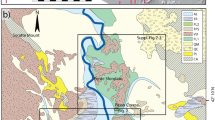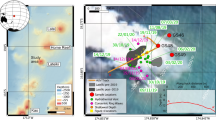Abstract
WIKLIAMS'S subdivision of calderas into ‘Krakatoan’ and ‘Glen Coe’ types1 has been the subject of recent discussion2–4. Williams's concept of the ‘Krakatoan’ mechanism is that explosive eruption of pumiceous volcanic products from the vents of a central-type volcano produces a void in the underlying magma chamber; the unsupported chamber roof then collapses, producing a caldera at surface level bounded by a ring-fault escarpment. The ‘Glen Coe’ type, on the other hand, is said to involve the stoping of magma up ring fractures and the coeval descent of the enclosed cylindrical block.
This is a preview of subscription content, access via your institution
Access options
Subscribe to this journal
Receive 51 print issues and online access
$199.00 per year
only $3.90 per issue
Buy this article
- Purchase on Springer Link
- Instant access to full article PDF
Prices may be subject to local taxes which are calculated during checkout
Similar content being viewed by others
References
Williams, H., Tech. Pub. Univ. California, Dept. Geol. Sci., 25, 239 (1941).
Yokoyama, I., and Tajima, H., Nature, 183, 739 (1959).
Yokoyama, I., Nature, 191, 966 (1961).
McCall, G. J. H., Nature, 197, 136 (1963).
McCall, G. J. H., Proc. Twentieth Intern. Geo. Congress, Sect. 1, 55 (1957).
MacDonald, G., Trans. Amer. Geophys. Union, 45, 642 (1964).
Author information
Authors and Affiliations
Rights and permissions
About this article
Cite this article
JOHNSON, R. Mechanisms of Cauldron Subsidence. Nature 210, 291–292 (1966). https://doi.org/10.1038/210291a0
Published:
Issue Date:
DOI: https://doi.org/10.1038/210291a0
This article is cited by
-
Evolution of Aoba caldera volcano, New Hebrides
Bulletin Volcanologique (1970)
Comments
By submitting a comment you agree to abide by our Terms and Community Guidelines. If you find something abusive or that does not comply with our terms or guidelines please flag it as inappropriate.



